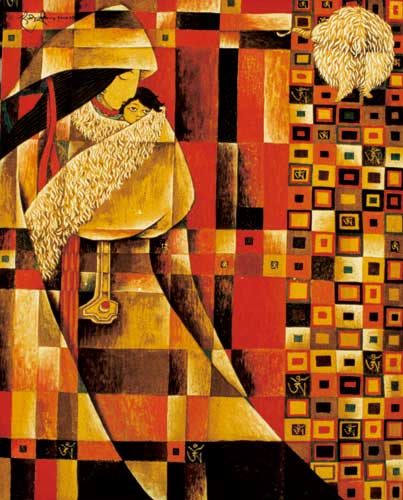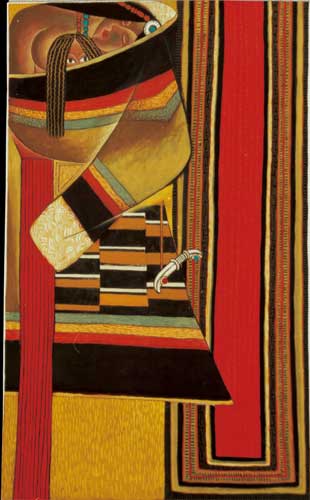| Homepage |
| New books |
| News in Brief |
| list of late magazines |
| Articles Recommended |
Articles Recommended |
|
· Tibetan Thangka Painter -- ... · Art Gallery in Lhasa · The Most Charming Pictures · Ngawang Jigme's Modern Wash... · Unique Illustrations in Tib... · Introduction of the K??la... · "Six Symbols of Longevity" ... · Humid acid · NEWS IN BRIEF · THE LAST TRADE CARAVAN IN T... · NYINGCHI, THE NATURAL BEA... · Tibetan Football · Horse Race in North Tibet · The Life of Herder Dargye · Transportation in Lhasa Cit... |
The Most Charming Pictures
By Jime Trinley

Mother and Childe
Art originates from the daily lives of people, i.e. all artworks are based on the actual lives of individuals. My principle of art production is to focus on singing the praises and eulogizing the love of motherhood - the loftiest spirit of mankind. Mother is recognized as the greatest hero of them all. To depict and laud the greatness of motherhood is my responsibility. Motivated by my pleasure in completing valuable and significant contributions to satisfying our beautiful dreams of motherhood, I was absorbed in art creation to express and eulogize the great loves of motherhood through many of my artworks produced in the 1980s and 1990s, such as "Frying Barley", "Breeding", a series of "Girls of Nomads", a series of "Tibetan Girls" and a series of "Mothers". The love given by mothers is disinterested, and I recognize that the realization of social harmony must rest on such spirit. My products and styles are just a fraction of hundreds and thousands of artworks. A benchmark of art should not be defined as "good or bad", but rather "beautiful or ugly".

Qinghai-Tibet Railway
"Frying Barley" is my graduation artwork from when I finished my study in the Art Department of Tibet University in 1980. My supervisor was Wang Xiaoming. In order to accomplish this oil painting, I paid several visits to my hometown - Dungkar Township of Tohlung Dechen County. Having produced lots of designs by taking the rural area as my motif, I was not succeeding. One day, my maternal aunt planed to fry barley but no person could help; therefore, I volunteered. I had actually experienced such activities many times before, but I didn"t pay too much attention. However, I watched what it was done very carefully at this time, including every scene, and recorded every activity on my sketch notebook. At the beginning, I drew many but none of them was what I really wanted, and the figures and layout were not satisfying at all. What confronted me was that I could hardly depict the scene of buzzing activity with frying barley, and what I drew would never surpass the common style. I felt I had missed something. Later on, I was inspired by the outside activities beyond the activity of frying barley. Upon that, my series of artworks on motherhood were born. Placing the figures of mother and son in the middle of the picture and frying barley as the background makes the whole picture active; it looks very impressive and is imbued with the love of motherhood.

Breading
My art style was gradually formed in the 1980s starting from my early artwork "Breeding". I continued showing the love of motherhood through my drawings. Of course, the later themes of my art are based on this principle. The means of expression in "Breeding" differs from "frying barley"; the first one focuses on decorated scenery but the second one is much more realistic. In "Breeding", I stressed decoration in picture layout and also figures" format. Adopting the colour style of early painting of Thangka, I particularly added more colours in a symbolic way in order to make figures vivid in the painting and background as well. My artworks impress people with their "Tibetan style" by integrating tradition with modernity, adopting both concrete with abstract approaches, and combining real life and the author"s personal feelings. I am fond of warm colours to depict what I want to express. I believe, only by doing this, could it well and truly give voice to the great affection of motherhood. Basically, I use four colours (red, yellow, black, and white) as my key colours, and take grey to adjust the warm colours. The red represents fire, and it also refers to sun and life; yellow represents noble or holiness or grandness; black refers to religion, it is the symbol of preventing evil spirits and represents the power of justice; white refers to light and hopes. It is the father of all colours, representing purity. Colours act as dancers, but sketching plays a role as a platform. I prefer to choose colours with sharp contrast and my matching colours are really adventurous. In regard to the format of figures, I pursue large and grand concepts to enhance strength in order to depict the unique and various contrasts on the plateau, including the contrast in elevations, sunlight, tradition and modernization, as well as people in reality and divinities in legends. Intentionally and unconsciously, I try hard to show such contrasts in my work through colours, dark and bright, personal figures, and formats.
My understanding of art production is that the process is of more importance than the results, and many happiness and joys actually come from the process.